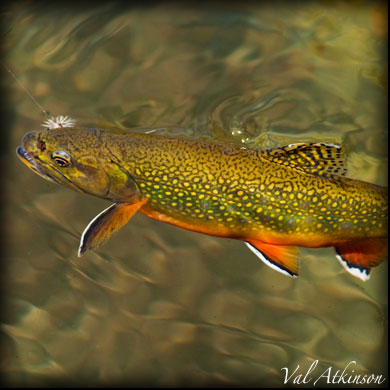
Identifying characteristics: (Native Fish) Brook trout have a long, streamlined body with a large mouth that extends past the eye. Color variations include olive, blue-gray, or black above with a silvery white belly and wormlike markings (vermiculations) along the back. They have red spots sometimes surrounded by bluish halos on their sides. The lower fins have a white front edge with black and the remainder being reddish orange. The tail fin is square or rarely slightly forked. During breeding time in the fall male brook trout can become very bright orange-red along the sides.
The brook trout can be found throughout many states in many creeks, streams, rivers, lakes, and in the Great Lakes. Brook trout require cool, clear, spring-fed streams and pools. They can be found under cover of rocks, logs, and undercut banks and have been described as stationary. Larger brook trout often inhabit deep pools moving to shallow water only to feed. They prefer temperatures from 57–60 degrees F.
Spawning generally occurs in the months of October and November. Mature brook trout seek riffle areas with gravel in spring-fed streams, spring seepage areas of ponds, lake shores with swift currents, or lake bottoms where groundwater seepage occurs for spawning. Female brook trout use their tails to create a spawning bed (or redd) in gravelly areas. Redds may measure 1 – 2 feet in size. Female brook trout can produce between 100 – 400 eggs depending upon the size and age of the individual. After spawning the female covers the eggs with gravel. Brook trout eggs must get continous amounts of oxygen in order for the eggs to survive. Depending upon water temperatures the eggs will incubate 2 to 3 months before hatching into sac fry.

The sac fry remain in the redd until their yolk sac is absorbed. Then, when they are about 1 ½ inches long, they venture away from the redd to feed. It takes about 2 to 3 years for them to mature and they usually do not live longer than 6 years. Brook trout living in streams often reach sizes between 7-9 inches. Great lake brook trout or coasters can attain larger sizes up to 25 inches and 10 pounds.
Brook trout have been described as voracious feeders with the potential to consume large numbers of zooplankton, crustaceans, worms, fish, terrestrial insects, and aquatic insects. Ephemeroptera, Trichoptera, and Diptera often make up a large component of their diet. However, they will often feed on whatever is most readily available.
Brook trout are avidly sought after by sport anglers, for food as well as for the sport. They can be caught by using various terrestrials, wet and dry flies.
